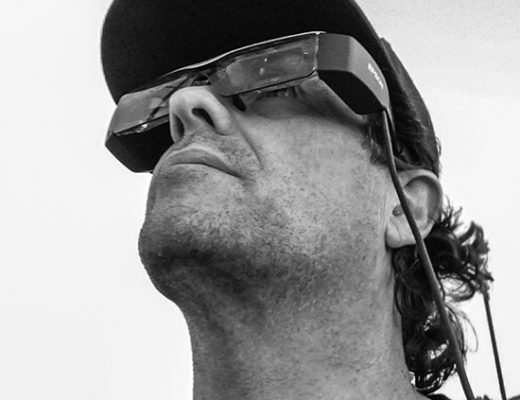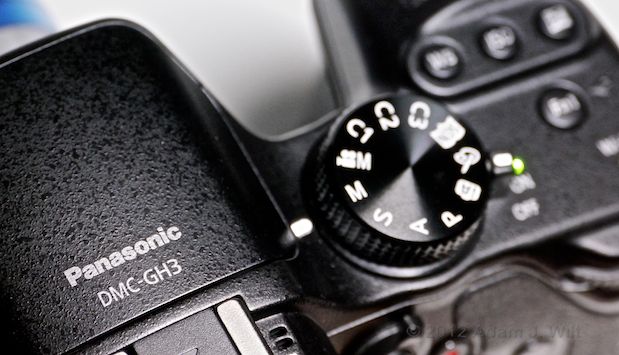
I’ve had my new GH3 for a couple of days now; long enough to work my way through the manuals and answer my burning questions about how it compares to the GH2 as a video camera, and time enough to learn some interesting things about its stills capabilities.
I’m not going to do a full review here; I haven’t had the time to thoroughly thrash the camera. What I can do is contrast its design and handling with that of the GH2, touch on some of the new capabilities the camera offers to still fotogs, and then look briefly at its video performance. If you need a good overview, DPReview has its usual meticulous preview while Luminous Landscape’s Michael Reichmann gives his hands-on impressions.
Design and Handling
The GH3 is just slightly bigger and a tiny bit heavier than the GH2; most notably, its right-side handgrip is rather more substantial. It also has its controls dispersed across the top and rear of the camera where the GH2 has them mostly bunched up on the right rear panel.
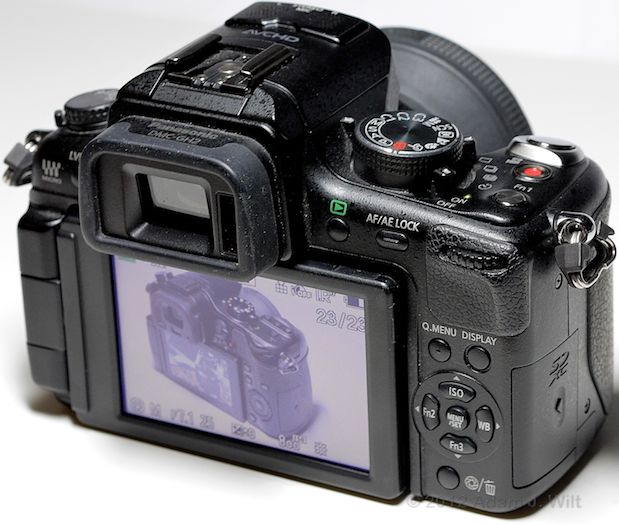
Panasonic DMC-GH2.

Panasonic DMC-GH3.
With the GH2 (and the GH1 before it), the small grip meant my fingers were pressed hard into the body, bracing it against the base of my thumb in a death grip, and the camera’s tiny, light-touch rear-panel buttons often got mashed in the process. The GH3 better fills my hand, so the entire hand contributes to the body’s support, and its controls are less likely to be pressed simply by trying to hold the camera.
With the GH2, I’ve become accustomed to having to reset DISPLAY whenever I pick up the camera, because more often than not I’ll hit DISPLAY with my thumb whether I want to or not. I also wind up whacking QUICK MENU, ISO, or WB often enough, simply trying to grasp the camera, that I’ve frequently changed settings I didn’t mean to.
On the GH3, the corresponding DISP. button is deeply recessed, so it takes a firm and intentional prod to trigger it, and the other buttons are far enough away from the grasping thumb that I have’t yet pushed one by accident (it’s early days yet, though).
The GH1 has its adjustment dial in front. The GH2 has it on the rear. The GH3 (finally) gives us both front and rear dials, as well as a Canon-like control wheel (with four-way rocker) on the rear panel. Gone is the modal two-parameter dial, where you have to press it in to switch parameters. By default, in Manual mode the front dial is iris and the rear is shutter; in Program, Aperture-, and Shutter-priority modes either dial will control the chosen setting. Exposure override (+/-) is no longer directly accessible at the spin of a dial, though; it (as well as WB and ISO) is selected with a top-panel button. Hit +/-, and the rear dial or the control wheel adjusts exposure compensation up to five stops in either direction, while the front dial separately adjusts flash compensation (nice!). For ISO, the rear dial or control wheel sets it, while the front sets the high-ISO limit for auto-ISO modes. Pressing WB lets you choose a white-balance setting with any of the three rotary controls.
The PLAY button has moved to the upper left rear panel, more where a Canon or Nikon user might expect to find it. The MF/AFS/AFC lever has moved from the top left plate to just right of the EVF, surrounding the AF/AE LOCK button; burst mode / bracketing / timer setting moves from a lever around the mode dial to become the sole control on the top left plate. Confusing? Not really, but if you’ve become accustomed to GH2 control placement, expect a few fumbles while you retrain your muscle memory.
There’s now a proper 3.5mm stereo mike jack in place of the GH2’s 2.5mm combo mike/remote jack, and the GH3 has a 3.5mm stereo headphone jack, too.
Like the GH2, the GH3 has a mini-HDMI output (which can be entirely decluttered for those wishing to record a clean feed on an external recorder). Like the GH2, the GH3 uses a !@#$%^&* proprietary combo A/V/USB connector, and it’s not the same one as on the GH2. It’s yet another hard-to-find special-purpose cable we have to carry around with us and buy spares of. Yah boo! Shame on you, Panasonic!
Underneath, a bigger battery slides in (it’s rated for about 160%-180% the life of a GH2 battery, and so far that rating seems to be honest), and its door hinge is slightly farther out from the tripod screw than on the GH2. For stills work, I have my cameras fitted with Manfrotto 394 quick-release plates, and the GH3 lets me change batteries with the plate installed, unlike the GH2. The GH3’s battery is curved on the top, like a Canon or Nikon battery, so it’s much harder to pop into the camera wrong way ‘round. The supplied charger now uses a separate AC cable (fortunately of conventional, standard design) instead of plugging directly into the wall.
The menu system is more elegantly styled than that of previous GH-series cameras, but it’s still a bit of a pig’s breakfast. I never have figured out the rationale behind the particular placement of many menu items: it isn’t obvious why some things are in Custom Setup instead of Setup or vice versa, why something is (or isn’t) in the Recording or Movie menus instead of one of the Setups, and so on. The GH3 continues this tradition (aided and abetted by the fact that the camera has approximately 1,872 different parameters to tweak [that’s a joke. I think…], so, as on most Nikon DSLRs, there’s a lot of settings to scan through if you can’t remember where something lurks). Where the GH3 has advanced is that it allows you to press the DISP. button to page through the menus; you don’t have the keep pushing up or down on the four-way rocker, or spin the control wheel constantly, to navigate quickly through all the options.
The GH3 retains the onscreen Quick Menus of its predecessors, too.
Overall, the camera’s interface is familiar but improved. Having two parameter dials instead of one is a big help in fast-moving situations—with the GH2, the single dial is invariably controlling the wrong setting when I need to change something in a hurry—though in more sedate studio work I find either camera equally usable.
Notable Features
Here are a few of the things that the GH3 does differently from the GH2, or that the GH2 doesn’t do at all. This isn’t a comprehensive list, it’s just stuff that leapt out at me.
Film Modes and Picture Styles: in place of the GH2’s multiple “film modes”, the GH3 offers a selection of “picture styles”: Standard, Vivid, Natural, Monochrome, Scenery, Portrait, and Custom. Nostalgic, Smooth, Dynamic, and Cinema are gone.
Each style is tweakable for contrast, sharpness, saturation, and noise reduction, as they were on the GH2, but each parameter’s range is +/-5 instead of +/-2. In quick (not definitive) testing, the strength of each incremental change seems to be the same on both cameras, so the total range of adjustment is more than twice as great on the GH3 as on the GH2.
Intervalometer: The GH3 has “time lapse mode” for full intervalometer operation. You can set intervals in one-second increments from 1 second to ten minutes, and total frame counts from 1 to 9999. You can also set up a start time, up to a day later, in case you need to delay your time lapse shooting for some reason. The camera will sleep between frames as needed to save power, waking up to shoot on schedule.
In-camera HDR is possible; the camera will capture and merge three images into one HDR JPEG. You can let the camera choose the exposure increments, or set them yourself, up to 3 stops difference between frames.
Stunt modes: The GH3 offers two mode-dial settings, SCN (Scene) and “creative control”, shown by an artist’s palette. Scene mode pops up a cover-flow-like scrolling set of sample images indicative of what the selected scene mode is supposed to render: “clear portrait”, “silky skin”, “sweet child’s face”, “romantic sunset glow”, “soft image of a flower”, “cute dessert”, etc. No, I am not making this up. Pressing DISP. shows you a normal image, a processed image, and a brief description of the transformations the scene mode applies.
Creative Control gives you somewhat less amorphous tweaks: “star filter”, “miniature effect” (tilt-shift-style edge blurring), “toy camera” (heavy vignette), and the like. The strength of most of these effects is variable, and viewable in real time onscreen.
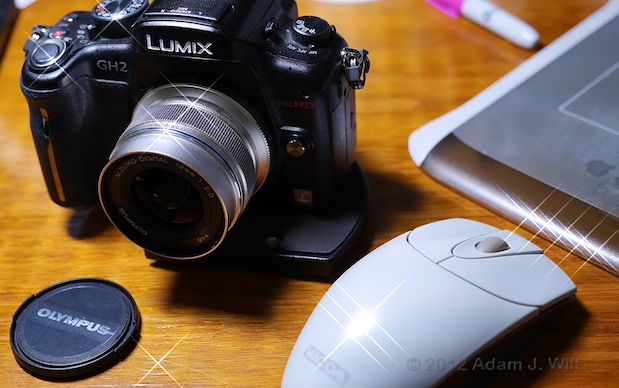
GH3 image using “star filter” creative control. You know you need this.
Some of these stunt modes are usable in video mode, too: see Nick Driftwood’s tests for a sampling.
WiFi: the GH3 has WiFi built in; it can serve as an access point or work through an existing one. Panasonic has a remote control app for iOS and Android, LUMIX LINK, that allows live viewing, touch focusing and power zooming (with power-zoom lenses), as well as remote image viewing.43rumors reports that an updated version with full GH3 remote control is due later this month, too. I loaded the current LUMIX LINK on my iPod touch and easily connected it directly to the camera—as long as I wasn’t in the app’s “menu” tab, which caused the app to crash whenever the camera was connected. When I was in shooting mode, the screen updated at around 10fps, and I was able to touch a focus area and trigger still captures (I didn’t try to record a video clip by remote control, yet).
The WiFi connection also allows uploading to Panasonic’s own cloud service (untested) or copying photos to a local machine as they’re shot (briefly tested; couldn’t get the camera to see my local Mac, or indeed any computers on the local ‘net).
Electronic shutter is the GH3’s hidden gem. Instead of using the mechanical focal-plane shutter, it captures a still entirely electronically, eliminating all shutter-induced vibration and noise. If you have an electronic lens attached with an aperture setting other than wide-open, you’ll still get the “chick-chick” noise of the lens irising closed and open again, but with a wide-open lens or a manual-iris lens like the Nokton 25mm f/0.95, the camera is utterly silent when taking a picture.
Utterly. Freaking. Silent.
The GH3 is the first interchangeable-lens camera I know of that’s usable in no-sound-allowed situations, like shooting production stills on a film set while the camera is rolling, or during a live theater performance, or when shooting in quiet auditoriums during presentations and conferences. Any candid or documentary photographer who has ever wanted to do away with the click of a shutter or the slap of a mirror will love the GH3’s electronic capture.
Drawbacks? Sure. It’s a rolling shutter that takes, in 3:2 aspect ratio, about 1/12 second to scan the entire frame (stills folks; think of a very slow-moving focal-plane shutter that fires the second curtain while the first is still in flight for any shutter speed higher than 1/12 sec). It’s a little bit faster for 16:9, a little bit slower for 4:3; it depends on the number of lines being read from the sensor.
You will get jellocam on fast camera or subject motion; if you’re working under discontinuous lighting, shutter speeds higher than the lamp’s cycle time (e.g., 1/120 for a symmetric, magnetic-ballast fluorescent in 60 Hz countries) will lead to alternating bright/dark bands in the image; and do watch out for CRTs in the image:

GH3 mechanical shutter, 1/100 second, fast pan.

GH3 electronic shutter, 1/100 second, fast pan.

GH3 electronic shutter, 1/60 sec, single fluorescent fixture and NTSC CRT.

GH3 electronic shutter, 1/120 sec, single fluorescent fixture and NTSC CRT.
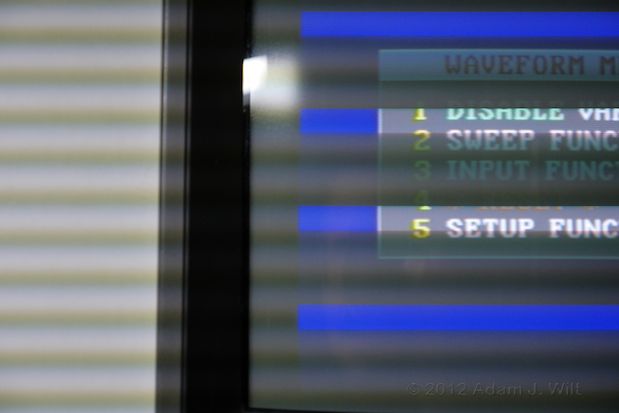
GH3 electronic shutter, 1/250 sec, single fluorescent fixture and NTSC CRT.

GH3 electronic shutter, 1/60 second, multiple fluorescent fixtures.

GH3 electronic shutter, 1/250 second, multiple fluorescent fixtures.
Next: Performance, and Hasty Conclusions.
Performance
I’m only going to address two issues here: video imaging and manual focusability. There are plenty of folks on the ‘net pixel-peeping high-ISO stills and debating 50Mbps long-GOP recording vs. 72Mbps intraframe recording, and I may report on the latter issue at a later time, but for now I’m just interested in fundamental image quality in video mode and how easily I can focus the camera. I shot my tests at 1080/24p, 24 Mbps AVCHD on both cameras.
Video Quality
I used the DSC Labs MegaTrumpet chart to look at the camera’s resolution and aliasing. Here ‘tis:

Pixel-for-pixel extract of GH3 image. Standard picture style, sharpness 0.
And, for comparison, the same chart shot with a GH2:
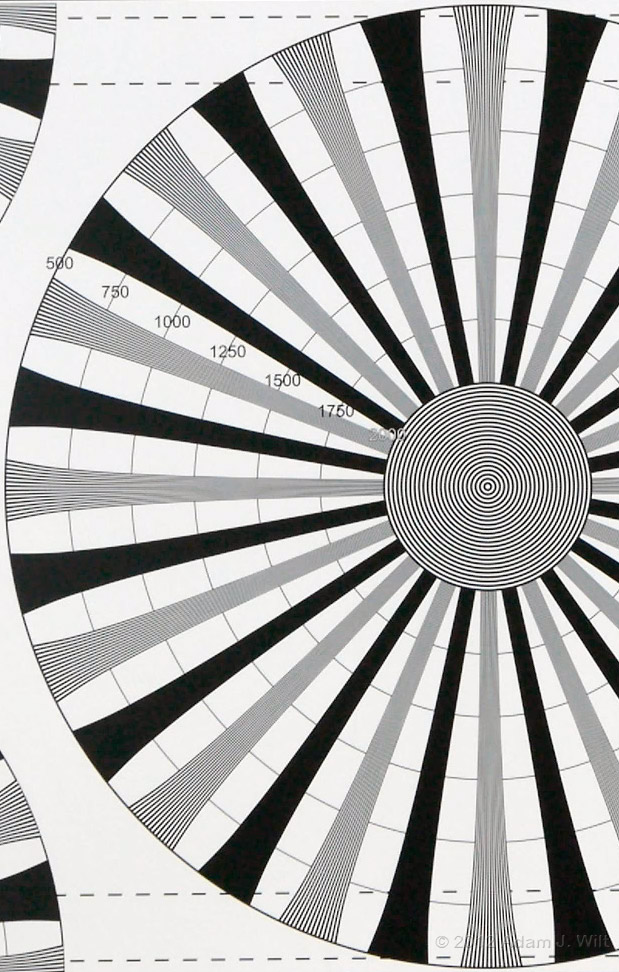
Pixel-for-pixel extract of GH2 image. Standard film mode, sharpness -2.
Do note that the GH2 was set to sharpness -2 while the GH3 was on sharpness 0.
Takeaway: the GH3 has about the same limiting resolution as the GH2: they’re both roughly 700-ish TVl/ph cameras, with substantial aliasing beyond that.
However, the character of that aliasing differs: the GH3 aliases more vigorously, and shows chroma moiré atypical of previous Panasonics, but it’s (paradoxically) somewhat cleaner and less obstreperous on contrasty edges: compare the visibility of artifacts in the 500-to-800-line regions of the horizontal and vertical trumpets.
This is borne out in non-chart images, too; near-horizontal lines usually tend to stairstep slightly less on the GH3, and details in high-contrast areas are a bit less chunky. Elsewhere in the image, aliasing is at a roughly comparable level much of the time, though aliasing in the GH3 image is sometimes slightly more visible.
Both the following video images were shot with the 12-35mm f/2.8 zoom at f/5.6, after manually focusing at f/2.8.
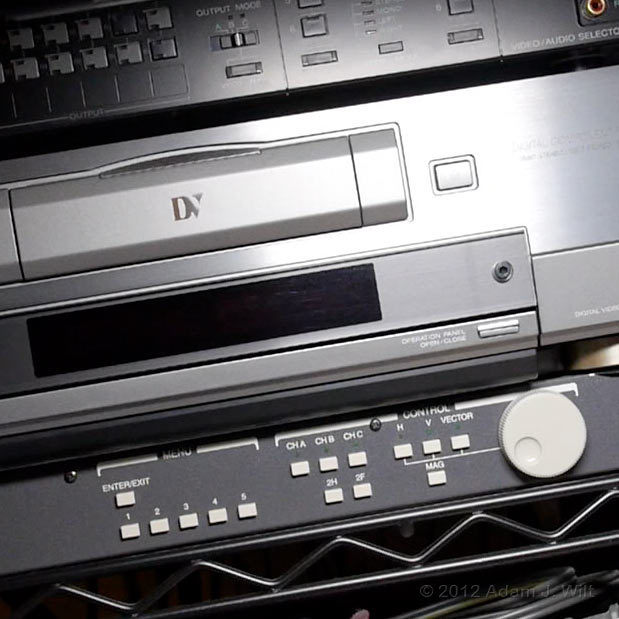
Pixel-for-pixel extract of GH3 image. Standard picture style, sharpness 0.

Pixel-for-pixel extract of GH2 image. Standard picture style, sharpness 0.
Observe that in this test the GH2’s image is about 1/4-1/3 stop brighter, and its highlights therefore clipped 1/4-1/3 stop sooner. When I swap the same lens between the two bodies to shoot at ostensibly the same settings, sometimes the GH2 is a bit brighter, and sometimes the GH3: I’m guessing I’m seeing some variance in actual aperture opening from test to test.
To do this properly, I should use a fully manual lens like the Nokton, and be darnedsure I don’t bump the iris while moving the lens from camera to camera.
That’s the nice thing about tests: there’s always another one that can be run…
Overall, I’d give the GH3 a very slight edge in overall spatial-rendering quality, due to reduced stairstepping in high-contrast areas, but it’s not a huge difference—not anything like the difference between, say, a Canon 5D Mk II and the GH2, or even the GH1 and the GH2.
In terms of tonal-scale handling, with both cameras in Standard film mode / picture style and all tweaks at 0, the GH3 tracks the GH2 very closely; the two cameras can be intercut undetectably. Both cameras appear to have the same gamma curve and highlight handling.
The GH3 has considerably more adjustment range in its picture styles, though, so I’m hoping I can capture a wider contrast range with it than I can with the GH2. A judicious combination of contrast -5 and an exposure compensation of -1/3 stop to hold highlights may be the ticket; more tests will be needed.
The GH3 does offer a bit more low-light capability: in Movie mode it’ll go up to ISO 6400 while the GH2 maxes out at ISO 3200. In the tests I’ve run so far (which haven’t been perfectly matched in terms of settings) I haven’t seen a substantial difference in noise levels between the two cameras. The GH3 may be half a stop cleaner—that is, it can gained up half a stop over the setting on the GH2 for comparable noise—but it’s hard to tell without a more rigorous test; the images are so close that without matching things exactly I don’t know if what I’m seeing is a difference in actual noise levels or just a slight difference in exposure. I will go so far as to say that the GH3’s noise seems to be slightly more tighter-grained than the GH2’s noise, but it’s not so far different that I wouldn’t (or couldn’t) intercut the two cameras painlessly.
In terms of color rendering, with both cameras in their default “standard” look, the GH3 shows the same saturation on the R-Y axis as the GH2, but B-Y is somewhat more saturated. The two cameras are close, but not identical.
Focusing
Both cameras offer manual focus assist, where the center of the screen is magnified to allow precision focus-twiddling. All fine and well, but expanded focus doesn’t work while the camera is recording, so being able to pull focus on an unmagnified screen is of keen interest to me.
The GH2 has one of the best EVFs around for focus pulling. It “only” has about 1.53 Mpixels, but it’s a monochrome LCD with color-sequential illumination. Its image is incredibly crisp and lifelike, with no pixel-level structure visible unless and until you get fine detail aliasing in the picture. Since the LCD is monochrome, each pixel butts up against its neighbor with no visible boundary and it’s possible to read small print (like the button labels on my rack of video gear) in the shot.
The GH3 uses an OLED display with slightly higher pixel count (1.74 Mpixels), but it’s a tri-color display with separate R, G, and B pixels. Yes, it has higher contrast; gorgeous, rich blacks; and no color fringing during saccades—but it’s soft by comparison. The pixel grid itself is just barely visible as a “screen door” overlay on the picture, and small print in the scene isn’t anywhere near as readable: it has to be twice as big in the image before it can be read.
Both EVFs resolve about 500 TVl/ph, but the GH2’s looks crisp while the GH3’s, by comparison, looks fuzzy. With focus assist off, I can quickly find focus on the GH2, but I’m never really sure of focus with the GH3. Disaster, ruination, and doom!
Fortunately, it’s not quite as bad once you start recording. With both cameras, going into record changes the rendering of the EVF image; the camera has to devote its energies to compression and recording, and so the displays suffer… but this suffering is good for focus.
On the GH2, the EVF display changes minimally. In standby, it looks crisp and clean, but fine details (like the res chart trumpets beyond the EVF’s resolution limit) alias without embarrassment. When recording, they alias with enthusiasm: a minor change, really, but one which crispens the image almost like peaking (well, if peaking rendered as aliasing, that is).
The GH3’s superior image-processing power lets it render a standby EVF image that’s perfectly smooth and antialiased; beyond the EVF’s resolution limits, fine detail turns to undifferentiated mush… which is theoretically correct and absolutely wonderful if you’re simply looking at pictures, but robs you of critical information when you’re trying to focus. Once the GH3 goes into record, though, all that fancy processing goes right out the window, and the GH3’s EVF starts aliasing just as vigorously as the GH2’s. While it’s still not quite as sharp as the GH2’s finder, I find (pun intended) that I can still focus using it with a fairly high degree of certainty; the added edging of the unfiltered aliases makes the image “pop” when it’s focused.
As to the flip-out LCDs, the GH2’s has 460 kPixels to the GH3’s 610 kPixels. Despite their visible dot structure and low pixel count, they work about as well as the EVFs for fine focusing. Both have a fair amount of edge enhancement, which works as a sort of poor-man’s peaking. The GH3 has a slight advantage due to its higher pixel count and higher contrast; it also shows slightly less color fringing, probably as a result of its higher density.
Hasty Conclusions
It is still early days; I haven’t had the chance to go out and use the GH3 on real jobs yet. But my initial impression of the GH3 is that it’s a solid upgrade over the GH2 as a still camera. Its dual control dials allow faster operation, its rearranged buttons mean fewer unwanted control changes when simply picking the darned thing up, its time-lapse capability is appreciated, and its WiFi connection promises useful remote control connections with the upcoming version of LUMIX LINK.
For me, the real selling point on the GH3 is its electronic shutter, which allows completely silent stills capture in hush-hush situations where even leaf-shutter cameras fear to tread.
As a video camera, it’s more of a mixed bag. So far, it looks to close enough to the GH2 in most aspects that, when both are set to comparable looks, their images can be intercut seamlessly, with few rendering differences bold enough to make one stand out compared to the other. And while I like the deep blacks and contrast of the OLED finder, it’s just not as sharp as the GH2’s color-sequential LCD is.
Of course the GH3 allows high-bitrate shooting—including a 50 Mbps long-GOP format that, by the numbers, even the BBC should allow—with no need for hacking by mad Russian geniuses(grin). The GH3 also has a headphone jack.
Consider that, right now, the GH2 sells for about half the price of the GH3… and the GH2 is a lot more than half as good.
If you need dual dials, a built-in intervalometer, in-camera HDR, the silent electronic shutter, unhacked high-bitrate video recording, and/or a headphone jack, the GH3 is clearly the way to go. If you need the sharpest, clearest EVF available; you’re happy with 24 Mbps AVCHD; and you can live without the features the GH3 adds, the GH2 is 90% of the camera for 50% of the price.
Bottom line: the GH3 is a very capable MFT still camera; a step beyond the GH2 with a price to match. But if you’re looking for a big leap in video performance over the GH2, the GH3 doesn’t appear to be it; it’s more like the move from an AG-AC160 to a 160A than the move from an HPX170 to an HPX250.
Even so, I’m not sending mine back.
Disclaimer: I pre-ordered the GH3 with my own money, sight unseen, several months ago (I did the same with the HPX200 when it came out; perhaps I should consult a behavioral therapist?). I paid full retail price. Panasonic did not support me in any way nor have they offered me any inducement to write this article.

Filmtools
Filmmakers go-to destination for pre-production, production & post production equipment!
Shop Now









